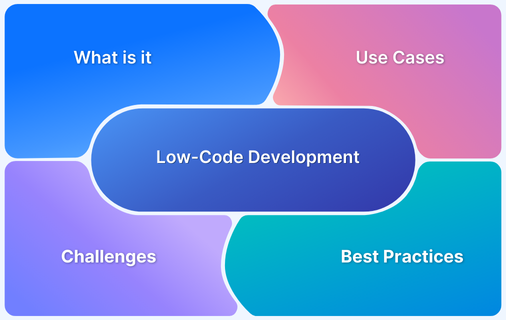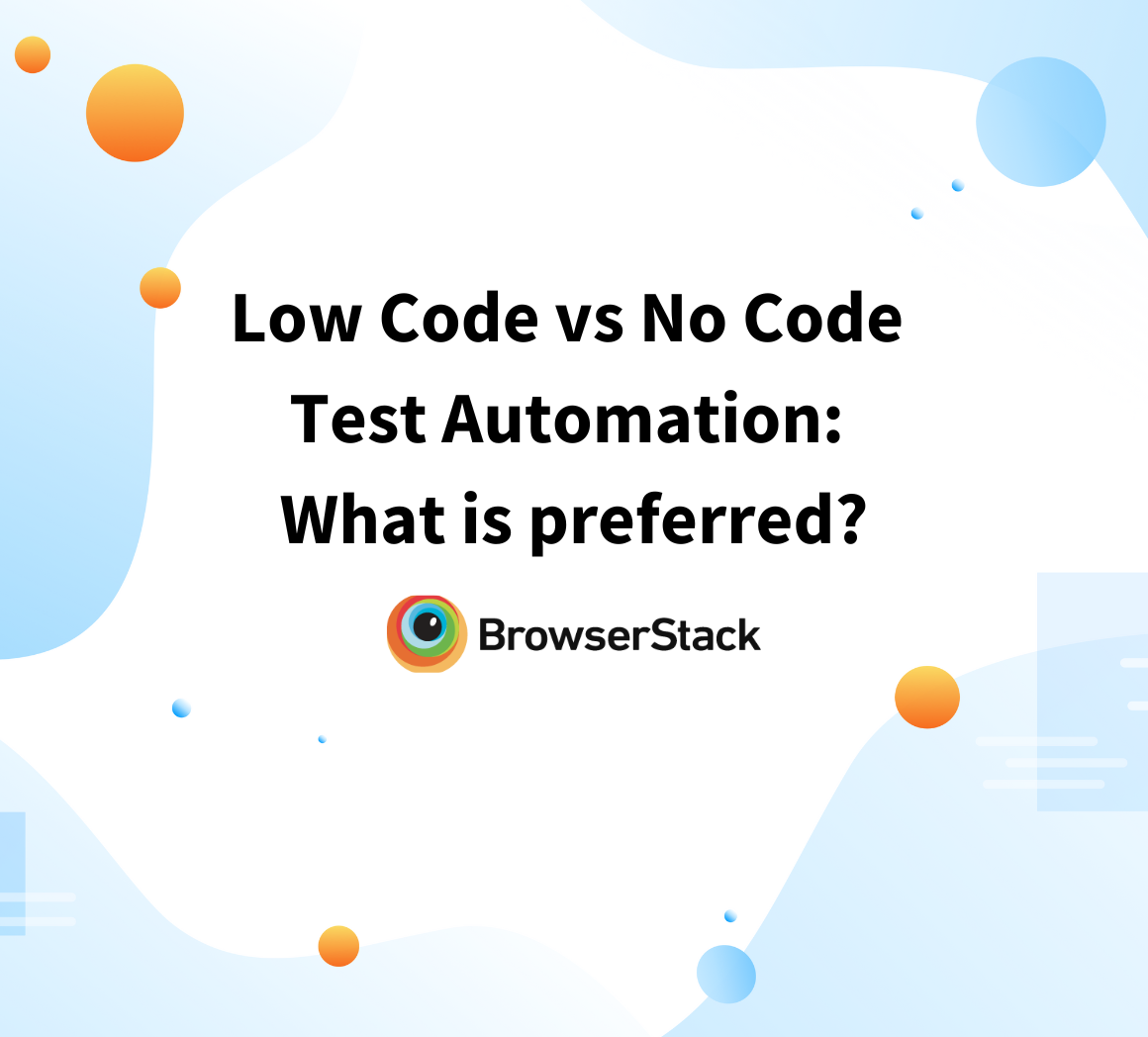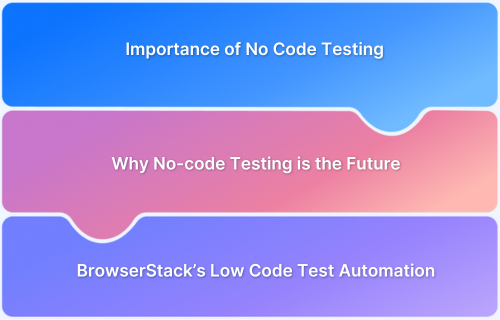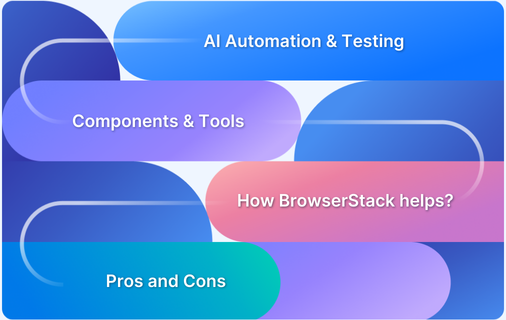Low-code development has emerged as a game-changer in the software industry, revolutionizing how apps are built with minimal manual coding.
Overview
Low-code development is a software development approach that allows users to build applications with minimal coding by leveraging visual interfaces, drag-and-drop functionality, and prebuilt components.
How It Works
Low-code platforms provide a graphical user interface (GUI) for designing applications, workflows, and data models. Developers use pre-configured templates, automation tools, and integrations to create applications with less manual coding, enabling faster development cycles.
Benefits
- Faster Development: Accelerates app creation with prebuilt components.
- Cost-Effective: Cuts development costs by reducing coding effort.
- Improved Collaboration: Bridges the gap between developers and non-tech users.
- Scalable: Simplifies updates and app scaling.
- User-Friendly: Empowers non-coders to build solutions easily.
This guide explores low-code development, explaining its advantages, distinct characteristics, limitations, and upcoming scope in the current era.
What is Low-Code Development?
Low-code development is an effective software development approach that enables developers to build applications via a visual interface and requires minimal coding efforts.
It allows developers and non-developers alike to build and customize applications by combining pre-built components, automating workflows, and managing integrations, reducing the complexity of traditional coding.
It is one of the easiest alternatives to traditional software application development.
Benefits of Low-code Development
According to the survey, 80% of respondents believe that accepting low-code development can free developers’ time, letting them to focus on high-value projects.
Whether your main aim is to deploy an app development platform or a comprehensive solution that unifies enterprise processes, low-code development brings multiple rewards to the organization.
Some primary benefits of low code development include:
- Speedy development
- Flexibility and scalability
- Increased agility
- Reduced development expenses
- Captivating UI/UX
- Better collaboration
- Streamlined updates and maintenance
- Innovation and digital transformation
- Improved productivity
Here is a detailed explanation of these benefits:
- Speedy Development: A low code platform lets the application development to be faster. It means developers can easily reduce their backlogs, the app will be accessible in the market faster.
- Flexibility and Scalability: Designed to be scalable and flexible, they can quickly adapt to varying business needs and accommodate growth without noteworthy development effort.
- Increased Agility: helps design and deploy new applications rapidly without extensive programming knowledge. This can aid companies in becoming more responsive and agile to changing market needs.
- Reduced Development Expenses- With fewer manual coding pains and organized workflows, low-code development considerably lowers development expenses. Businesses can efficiently allocate resources, maximizing their ROI.
- Captivating UI/UX: Developers can easily design a solution from scratch, and tailor it with in-built templates, to make an appealing UI, all this while ensuring zero compromises on performance or functionality.
- Better Collaboration: Business stakeholders can aggressively participate in the app development, guaranteeing that the end product aligns with their needs. Such a collaborative approach promotes innovation and expedites the SDLC.
- Streamlined Updates and Maintenance: Low-code development are typically simpler to maintain and update.
- Innovation & Digital Transformation: Empowers businesses to embark on digital transformation journeys by rapidly creating innovative solutions. It enables companies to adapt to the growing technology landscape and market intelligently.
- Improved Productivity: Low-code development enables more applications to be built quickly. Hence, with low-code development, time is a zero barrier to real invention.
Differences between Low Code and No Code
Both low-code and no-code development platforms empower citizen developers and professional developers to build apps. Such platforms’ significance lies in allowing users with little to zero coding experience to build apps that address multiple business challenges.
- Low-code platforms offer visual development tools and pre-built elements to accelerate app development.
- No-code development needs no coding at all. Novice users can use no-code platforms to create apps by easily dragging and dropping components and configuring settings.
Here is a comparison of Low-Code and No-Code development:
| Parameters | Low-Code Development | No-Code Development |
|---|---|---|
| Target Users | Citizen and Technical Developers | Citizen Developers |
| Coding Knowledge | Low-code is introduced for developers and a little coding is needed to utilize them. The platform delivers modes of automating things rapidly, but only for persons with tangible coding expertise. | No-code is mainly designed for business executives/ citizen developers; zero coding know-how is required. |
| Projects Complexity | Ideal for moderate to complicated projects. | Suited for easy projects. |
| Customization | Offers greater custom choices. | Offers restricted customization capabilities |
| Development Time | Speedy development due to some coding. | Rapid development without coding. |
| Flexibility | Higher flexibility in designing workflows. | Restricted flexibility in workflows. |
| App complexity | Can build complex apps. | Can build simple and easy-to-use apps |
| Learning Curve | Moderate learning curve for users. | Simple to use with minimal learning |
| Scalability | Ideal for scaling big projects | Suitable for smaller projects. |
| Control | Offers more control over the process. | Less control, automated approach. |
| Integration Capabilities | Robust integration with other systems. | Restricted integration possibilities. |
[Note: Both options cater to distinct user profiles and project needs, making them valuable tools in the software development arena.]
Differences between Low Code and Traditional Application Development
Low-code development enables rapid application creation through visual interfaces, reducing the need for extensive coding, unlike traditional development.
While traditional development relies on professional developers’ custom coding providing highly customized solutions, Low code development allows both technical and non-technical users to participate in the development process.
Traditional development requires longer development times and deeper technical expertise compared to low code development.
| Aspect | Low-Code Development | Traditional Application Development |
|---|---|---|
| Coding Requirement | Minimal coding; uses visual tools | Extensive coding; relies on manual coding |
| Speed of Development | Faster; allows rapid prototyping and deployment | Slower; requires detailed, step-by-step coding |
| Target Users | Developers and non-developers | Primarily professional developers |
| Customization Flexibility | Limited to pre-built components | Highly customizable with full control |
| Maintenance | Easier updates through platform management | Manual updates and patch management |
| Cost | Generally lower; reduced development costs | Higher; involves extensive development resources |
| Application Complexity | Best suited for simpler, standard applications | Suitable for complex, custom solutions |
| Scalability | May have scalability limits due to platform | Highly scalable, depending on development choices |
Key Components/Features of Low-code Development
The best low-code development platforms have a comprehensive suite of components and features designed to fast-track your journey to success.
Key Components of Low Code Development
- Visual development environment
- Drag-and-Drop interfaces
- Pre-built templates and components
- Mobile-first design
- Integration capabilities
- Cross-platform accessibility
- Security and compliance
- Workflow automation
Here is a deep dive into the essential elements that make up the foundation of low-code development.
- Visual Development Environment: Low-code platforms give a visual development surrounding with drag-and-drop functionality, letting software developers build apps without immense coding.
- Drag-and-Drop Interfaces: Drag-and-drop must be at the top of your listing regarding necessities in a low-code platform. This is not merely a convenience; it’s highly significant. Citizen developers require this to build their apps.
- Pre-Built Templates and Components: Low-code platforms also proffers a library of reusable elements and pre-built templates, letting app developers accelerate app development.
- Mobile-First Design: Low-code platforms prioritize mobile optimization, confirming that apps are responsive and accessible across multiple devices.
- Integration Capabilities: Low-code platforms provide seamless integration with numerous third-party databases, solutions, and APIs, letting developers build robust and interconnected apps.
- Cross-Platform Accessibility: If you are building an app using one of the low-code platforms available on the marketplace, this is a great trait to have. Building an app with multi-channel compatibility, which lets your manpower access it from any place, makes things simple.
- Security and Compliance: Low-code platforms execute robust safety measures and compliance standards to protect confidential or sensitive info and guarantee regulatory adherence.
- Workflow Automation: Low-code platforms allow the automation of recurring jobs and business procedures, enhancing productivity and efficiency.
Real-World Use Cases of Low Code Development
Some low-code use development in enterprise settings include:
- HR Management: Big enterprises use low-code platforms to build comprehensive HR management systems that automate employee recruitment, onboarding, performance assessments, and training.
- Financial Management: Low-code solutions generate financial management apps that handle budgeting, financial expense tracking, invoicing, and reporting.
- Supply Chain Management: Low-code platforms are also leveraged to build supply chain management apps that manage inventory, track shipments, and confirm seamless logistics operations.
- CRM (Customer Relationship Management): Enterprises deploy low-code Customer Relationship Management solutions to organize customer info, enhance customer engagement, and streamline marketing and sales processes.
How do Low Code Development Tools Work?
Low-code development tools work by providing a platform with visual, drag-and-drop interfaces and pre-built components. It allows users to build applications quickly and with minimal coding. Here is how low code development works:
Step 1: Design with Drag-and-Drop
Arrange components visually using a drag-and-drop interface. This allows users to build layouts without coding.
Step 2: Use Pre-built Modules
Choose from a library of ready-made templates and modules. Customize these as needed to speed up development.
Step 3: Automate Workflows
Set up automated processes. Define business logic with easy-to-use, conditional workflows.
Step 4: Integrate Data Sources
Connect to external databases and APIs. Use built-in connectors for seamless data flow.
Step 5: Customize with Code (Optional)
Add custom code for unique features not covered by built-in options. This enables a hybrid approach.
Step 6: Test and Deploy
Simulate app behavior before launch. Deploy with single-click options, which often automate versioning and scaling.
Step 7: Collaborate and Manage Roles
Allow team collaboration by assigning roles and access levels. This lets both technical and non-technical users contribute.
Challenges and Limitations of Low-Code Development
Even though low-code development brings myriad benefits, it also comes with certain limitations and challenges:
- Restricted Flexibility: One of the most significant challenges of low-code development is its partial flexibility. While low-code platforms offer pre-built modules and templates for speedy development, these elements might only sometimes be fully customizable to meet precise and intricate business requirements.
- Limited Control: Ease of usage comes at the cost of fine-grained control over the app development procedure. Advanced developers accustomed to old coding practices may find it tough to control the app’s complexities completely.
- Security Concerns: Security is a crucial consideration in development. Although reputable low-code providers implement strong security features, companies should remain vigilant and guarantee their apps are protected adequately from potential data breaches and cyber-security threats.
- Performance Limitations: While low-code platforms prioritize ease of development every so often, they might not optimize performance to a similar extent.
Best Practices and Tips for Successful Low-Code Development
Successful low-code development needs a strategic adherence and approach to best practices to confirm reliable and efficient app delivery. Here are some crucial tips and best practices to accomplish success with low-code development:
- Plan before you begin: Define your requirements, identify the key traits, and decide on the UI design.
- Pick the appropriate low-code platform: Consider the platform’s ease of use, flexibility, integrations, and scalability with other systems when deciding.
- Keep it simple: One of the crucial benefits of low-code development is its simplicity. Avoid over-complexing your app by keeping it easy to use.
- Maintain Coding Standards: Even in a low-code environment, sustain coding standards and best practices to make sure readability, consistency, and maintainability of the app’s codebase.
- Implement robust security measures: Prioritize and follow industry-standard safety protocols to safeguard sensitive data and control potential vulnerabilities.
- Use agile methodologies: Utilizing agile methodologies in low-code development can aid you in attaining better results. You can rapidly determine and address bugs by breaking the development procedure into smaller, manageable sprints.
- Document your app: Documenting your application is also one of the effective approaches to ensure that developers can easily understand and manage it. Ensure you document the app’s traits, functionalities, and any customize made during the development workflow.
- Conduct Rigorous Testing: Comprehensively test the app to detect and resolve any bugs or functional loopholes. Use testing tools, comprising visual testing and cross-browser testing, to ensure the app function seamlessly across various platforms. Low code automation testing is an innovative approach that simplifies the creation and execution of automated tests by reducing the amount of manual coding required. This method leverages visual interfaces and test recorders to enable testers, even those with minimal programming experience, to efficiently design and manage test cases. By utilizing a low code automation tool, teams can accelerate the testing process, enhance collaboration, and reduce the risk of errors typically associated with manual testing.
How to choose a Low Code Development Platform?
Here are some essential factors to consider on how to choose a low-code development platform:
- Relevance to the Use Case: Choose a platform suited to your project type (for example, web, mobile, or internal tool).
- Easy to Use: Ensure the platform is intuitive for both technical and non-technical users.
- Customization: Look for options to add custom code if unique features are required.
- Integration Capabilities: Make sure it connects easily with the databases, APIs, and services you need.
- Scalability: Verify the platform’s performance as usage grows.
- Security: Confirm it meets your security standards and compliance needs.
- Support: Look for team support and solid customer service.
- Cost: Compare pricing with the features offered to ensure good ROI.
Why Choose BrowserStack Low Code Automation?
With BrowserStack Low-Code automation, you can make sure that your apps are user-friendly, reliable, and robust, offering a smooth experience for your users and driving business growth. It is a platform to create and run automated tests at a faster velocity without the need for writing test code and a low learning curve.
Key Features:
- Intuitive Test Recorder: Specify the URL to test and perform actions on your website, just like manual testing. The recorder automatically captures the corresponding steps for you.
- Visual Validation: Easily verify complex assertions by just adding visual validations during recording.
- Intelligent Step Timeout: Detect optimal wait time-out based on network requests and page navigations and waits for elements to become actionable.
- Self-healing: Eliminate the need for manual test updates when changes are detected.
- Cloud Execution: Create test suites from your recorded tests and execute them on BrowserStack cloud.
- Testing on Dev Environments: Record websites on your internally hosted environments and replay them on the cloud with minimal setup.
BrowserStack Low-Code Automation covers all aspects of the testing lifecycle, including test development, test execution, and test reporting. Sign up now to harness the full potential of low-code!
Future of Low-Code Development (2024 & Beyond)
Organizations are increasingly adopting low-code platforms to accelerate their digital transformation initiatives and respond to market changes swiftly.
- As per a report by MarketsandMarkets, the low-code development platform market is estimated to hit US$ 45.5 billion by 2025, at a CAGR of 28.1% during the prediction period.
- The rising demand for digitalization and Agile with DevOps practices is estimated to increase worldwide.
- Moreover, 66% of organizations view digital transformation and enhanced responsiveness to business requirements as the prime drivers behind accepting low-code development platforms.
These statistics and reports demonstrate that low-code development isn’t just a trend but a revolutionary shift in software development. With its potential to drive innovation, productivity, and cost-efficiency, low-code development is the future of app development that no organization can afford to ignore.
Follow-Up Read: Why No Code is the Future of Testing
Conclusion
Low-code development transforms how businesses build and deploy applications. It enables rapid, cost-effective solutions without heavy coding. It speeds up development, allowing teams to iterate faster, integrate smoothly, and deliver high-value features.
For teams embracing low-code development, BrowserStack’s Low Code tool is a powerful test automation platform to ensure quality at every stage of development. With its intuitive test recorder, simply specify your URL and perform actions to auto-capture steps.
Verify complex assertions using visual validation while intelligent timeouts ensure smooth execution. Experience self-healing tests, seamless cloud execution, and easy testing on dev environments.





